Kenwood has been a market leader in the two-way radio and is recognized by consumers and industry professionals for providing products known for quality, performance, and value.
Analogue Radios
Kenwood analogue licensed and license free hand-portable walkie talkies, mobile units, base stations and repeaters offer cost effective voice and data communications for business radio users. In addition to peer to peer communications, wider area coverage and additional functionality may be achieved through the addition of MPT 1327 protocol trunking.
Kenwood Digital
When Kenwood introduced its NEXEDGE® range of advanced digital two-way radios in 2008 it was the first system to offer both Mixed Mode (the ability to communicate with both analogue and digital handsets automatically, without manual switching) and trunked radio communication capability.
Built on the solid foundations of over 30 years of success and now with over 600,000 devices in use around the world, Kenwood NEXEDGE® equipment has proven that it is able to deliver clear voice quality and reliability, even in the noisiest of environments while its digital encryption provides complete protection against casual eavesdropping.
All NEXEDGE® equipment can communicate with existing analogue radios, either terminal to terminal, as a system, or even as a multi-site trunked network. This provides a cost effective and controlled solution to customers migrating from an analogue system to the proven advantages of digital.
Winner of the Innovation in Business Radio Award at the 2010 Federation of Communications Services AGM, NEXEDGE® has been designed to deliver the safety, security, efficiency, performance and future-proofing that the market demands from leading edge digital two-way radio communications.
NEXEDGE® Advantages
Spectrum Efficient
All NEXEDGE® equipment operates in 25 & 12.5 kHz analog and 12.5 & 6.25 kHz NXDN™ digital modes – satisfying spectrum requirements today & tomorrow.
Migration by Design
NEXEDGE® extends the life of current radio system assets. All NXDN™ digital modes use the same Class-C power amplifiers and site management equipment used for current analog stations, ensuring return on investment (ROI) and a multitude of supplier choices. Current analog and NXDN™ digital fleets can share a NEXEDGE®base/repeater station in 12.5 kHz conventional “Mixed Mode,” thus providing uninterrupted service as long as needed and a straightforward migration path as aging analog fleets are replaced with digital. Also, NEXEDGE® trunked traffic channels can be shared with existing external analog conventional or trunked logic controllers, extending service to fleets as a transition to NXDN™ trunking is underway.
Variety of Operation
NEXEDGE® systems are configurable in traditional conventional, trunked and wide area trunked network operation modes. IP connectivity for NEXEDGE® trunked sites provides scalability over existing LAN/WAN assets and services.
Outstanding Voice Quality
The AMBE+2™ Vocoder is a state-of-the-art voice compression digitization technology that offers superior clarity at varying signal strengths, even at highway speeds.
Secure Privacy
NEXEDGE® technology offers inherent security against casual electronic eavesdropping via its digital air interface. It also includes NXDN™voice & data scrambling for security against external threats while providing confidentiality within the same system and talk group. Inter-network links are further secured through encrypted VPN tunneling. Also NEXEDGE® multi-site network operators can automatically validate individual subscriber radio hardware by ESN (a unique factory-embedded Electronic Serial Number ) rather than changing the system’s unit and group ID lists in the event a unit is lost, stolen, or removed permanently or temporarily from service.
More Information in Less Time
All NEXEDGE® system operational modes – conventional, trunked and networked – share exceptional feature benefits. The 65,519 IDs for a conventional system and 60,000 IDs for a trunked system accommodate large fleet and multi-user shared systems for dispatch talk group calling and individual private unit-to-unit calling. Unit ID/Group ID validation facilitates subscriber access and call privileging. Paging reduces unnecessary voice traffic and each subscriber unit stores the last 5 pages for recall. Especially useful on mobiles, a voice storage option can be added for stored-voice message paging. Emergency features can alert a dispatcher, a supervisor or a whole talk group to a unit in distress. The All Group Call feature supports system/facility-wide general, emergency or evacuation communications. Also, NEXEDGE® original Over-the-Air Alias provides instant caller ID regardless of fleet programming. Remote Stun and Kill features temporarily or permanently disable lost or compromised subscriber units to prevent system interference, while Remote Check enables a dispatcher to make non-voice in-range subscriber unit checks. All subscribers have simultaneously voice and GPS capability for automatic fleet tracking.
Asset Management with ROI
The NEXEDGE® System Manager for NXDN® trunked sites and networks reduces operational and maintenance costs with remote programming, firmware uploading, subscriber unit privileging, monitoring and diagnostics capabilities all from a secure user-friendly Windows®-based application via direct connection, dial up modem, or IP connection.
AMBE+2™ is a trademark of Digital Voice Systems Inc.
Windows® is a registered trademark of Microsoft Corporation.
Technologies
The NXDN® Digital Advantage
In analogue systems as the signal strength decreases in low-coverage areas, noise and dropouts increase, severely degrading intelligibility. However, with the NXDN® digital system, which features enhanced Forward Error Correction (FEC), the digitized audio stream is less susceptible to noise, resulting in superior clarity at varying signal strengths. System operators converting from analogue to NEXEDGE® typically comment that users now receive calls in areas that were out of range before. NXDN® reduces lost or misinterpreted calls and the need for repeat calls, thus enhancing workforce productivity.
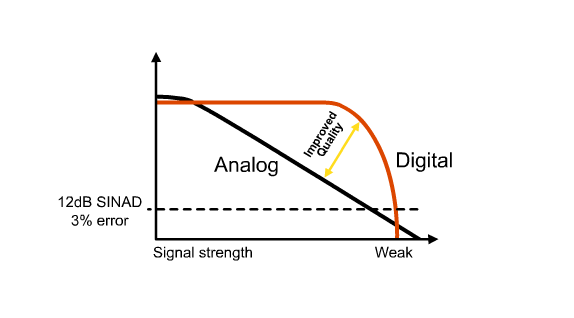
NXDN™
A key element of the NXDN™ air interface is the AMBE+2™ vocoder which digitises speech while retaining natural voice nuances, performs noise reduction, introduces FEC and compresses this voice data to accommodate land mobile radio data rates. Next, the radio’s digital signal processor (DSP) protocol- packages the vocoder, signaling, control, and more FEC data together and converts this to a uniquely filtered 4-Level FSK digital waveform that modulates the transmitter. This results in an unusually low bit-error-rate digital air interface delivering robust communications even in weak signal strength areas. The NXDN™ air interface is capable of fitting into both narrow 12.5 kHz and very narrow 6.25 kHz bandwidth channels meeting the tightest of spectrum efficiency requirements (9600 bps @ 8.3 kHz and 4800 bps @ 4 kHz occupied bandwidth respectively). NXDN™ is a Frequency Division Multiple Access (FDMA) methodology whereby one user accesses a channel frequency at any one point in time (i.e. accesses via the frequency domain). Other digital methods such as Time Division Multiple Access (TDMA) permit more than one user to access the channel frequency via timeslots (i.e. accesses via the time domain), but there has to be a tradeoff between coverage and effective transmission rate, as increasing the former means decreasing the latter.
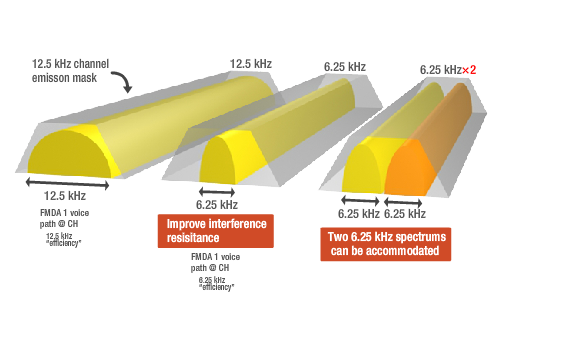
Operating Modes
NEXEDGE® systems support the following NXDN™ digital modes:
- Digital Conventional
- Digital Conventional IP Networks
- Digital Trunked
- Digital Trunked Wide Area IP Networks
In addition, NEXEDGE® equipment can support legacy analogue modes.
Note: in combination with the KVT-11 Image Encoder and the KAS-11 Image Viewer, a NEXEDGE® wireless system can acquire still pictures from remote video cameras.
Digital Conventional Mode
NEXEDGE® base units include a 16-RAN(Radio Access Number) capacity conventional repeater controller for 16 user group site sharing. The 65,519 (each) Group ID and Unit ID capacity adds group and individual selective calling capability beyond conventional analogue. Also Mixed mode operation allows analogue & NXDN™ conventional units to share the same RF channel.
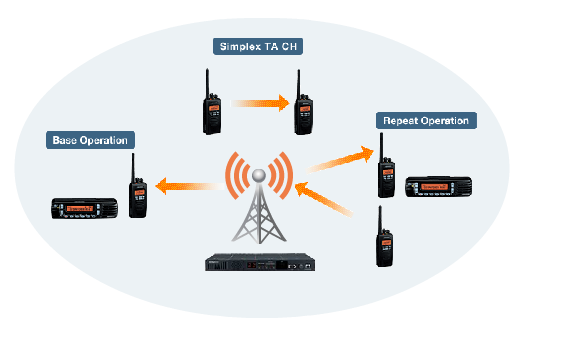
Digital Conventional IP Networks
NEXEDGE® Conventional IP links up to 16 or 48 digital conventional repeaters* into one system for wide area coverage or coverage fill-in extensions. As users roam throughout the network the subscriber units use the beacon signals and to choose the best repeater for communications.
* Version 2.0 or later and certain routing type required [16 (unicast); 48 (multicast)] for maximum number of repeaters per network.
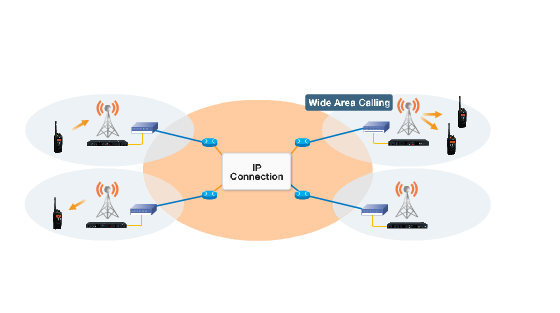
Digital Trunked Mode
NEXEDGE® trunked mode provides increased capacity, enhanced call capabilities, improved
security and faster communications with less required user operation than conventional systems. The system automatically assigns channels for faster, efficient use of spectrum, allowing users to concentrate on the job at hand. The 3,000 (each) Unit ID and Group ID per-site capacity provides ample unit and fleet organization capabilities. Group and Individual calls enjoy complete privacy as other users in the system cannot monitor the calls. The Priority Monitor feature will monitor for up to 4 high priority talk groups and switch users to those calls in progress so important calls are not missed. During peak usage hours, system Call Queuing stacks call requests and processes calls when a channel becomes available. System operators can assign important individuals higher queue priority and even pre-empt lower priority users for more important dispatch and emergency calls.
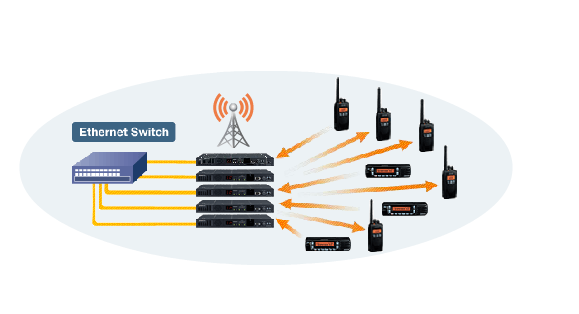
Digital Trunked Wide Area IP Networks
The network option leverages the power of IP to link up to 48 digital trunked sites together for wide area roaming and calling capabilities. Scalable networks can be created over existing IT assets, private microwave, spread-spectrum links or carrier services using standard 10/100 Base-T Ethernet switches and routers. IPSec VPN tunneling provides encrypted, secure communications links within any IP network. Subscriber units use advanced control channel hunting algorithms, RF signal strength and digital signal quality (low bit-error-rate) to automatically determine the best sites to register on while moving throughout a network. The 60,000 Group ID and Unit ID network capacity is sufficient for large organizations and multi-user system sharing.
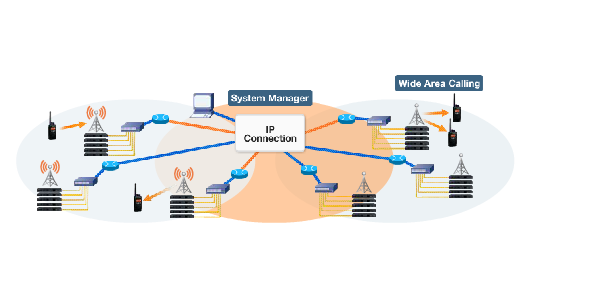
Wireless Image System

This innovative system consists of a monitor station and a base station, linked via NEXEDGE® digital transceivers. Still images are transmitted from the remote site to the base station computer, which serves as the control center. This allows the simultaneous monitoring of several sites where it would be difficult or uneconomical to install wired communications infrastructure – waterways, dams, national parks, temporary construction sites and so on.
Kenwood Solution Developers
To harness and exploit the full potential of Kenwood two-way analogue and NEXEDGE® digital radio equipment, Kenwood has introduced the Kenwood Solution Developers Programme (KSDP).
Leading application developers have been selected for innovative and unique solutions that integrate seamlessly with Kenwood NEXEDGE® digital and other Kenwood two-way analogue radio products.
Every specialist company in the Kenwood Solution Developers Programme has been selected for their software and/or hardware solutions designed to work with Kenwood NEXEDGE® or analogue radios. While KSDP members are all independent companies, they are nonetheless part of the extended Kenwood family in recognition of their commitment to delivering the highest standards of quality and service.

The Kenwood Solution Developers Programme underlines the company’s commitment to long term investment in the NEXEDGE® digital radio communications system into the future.
